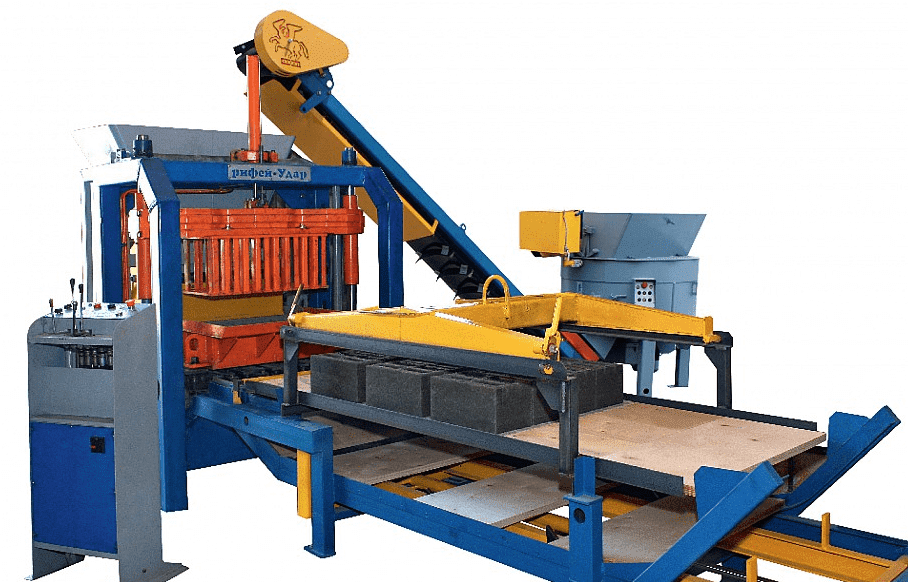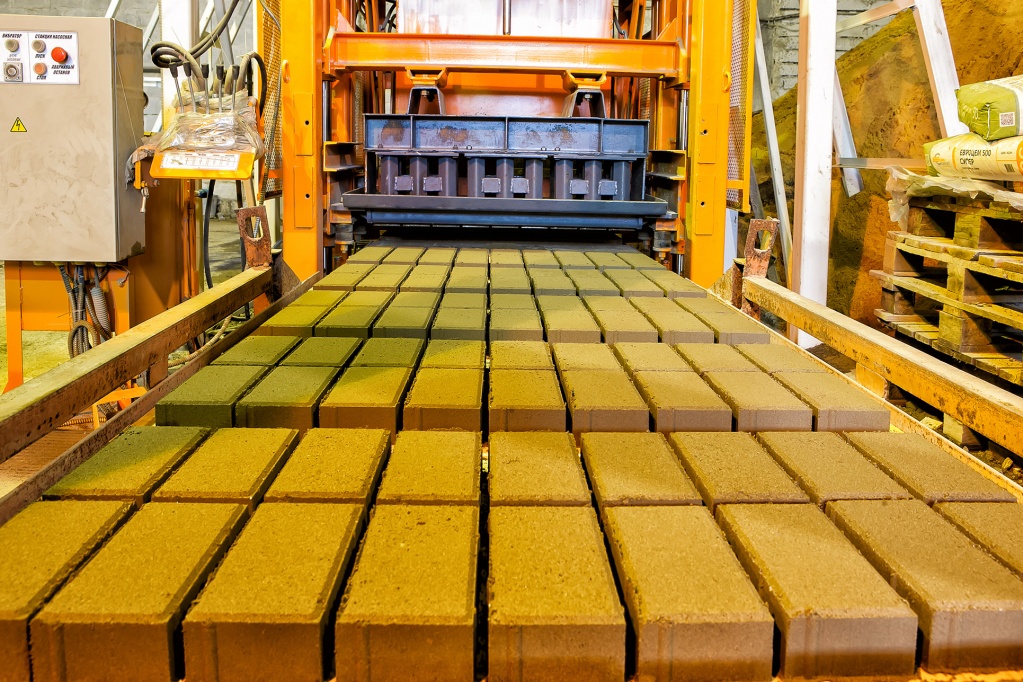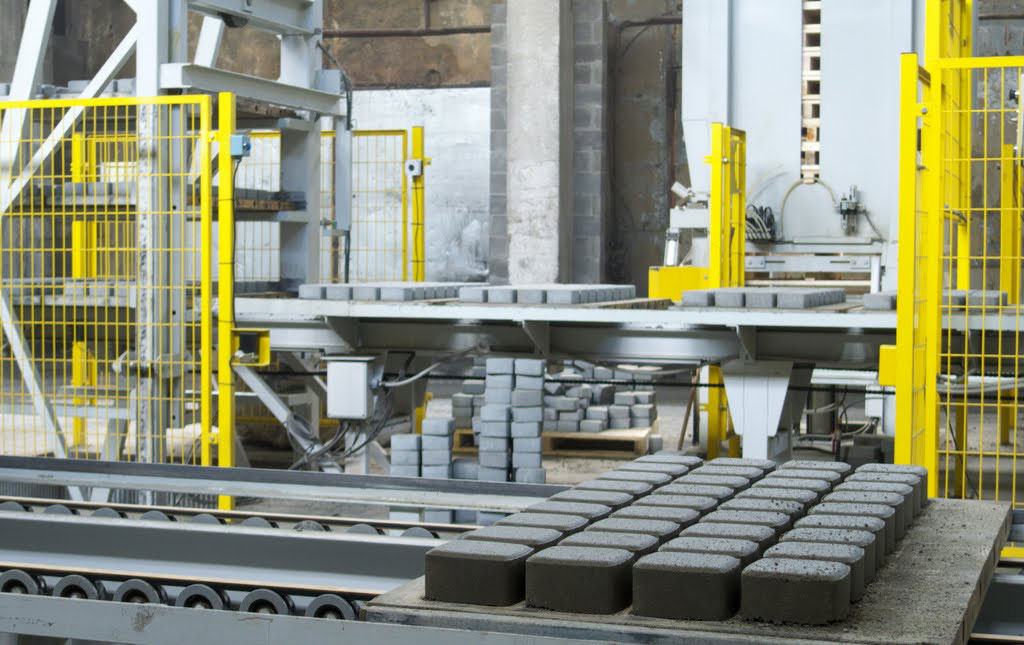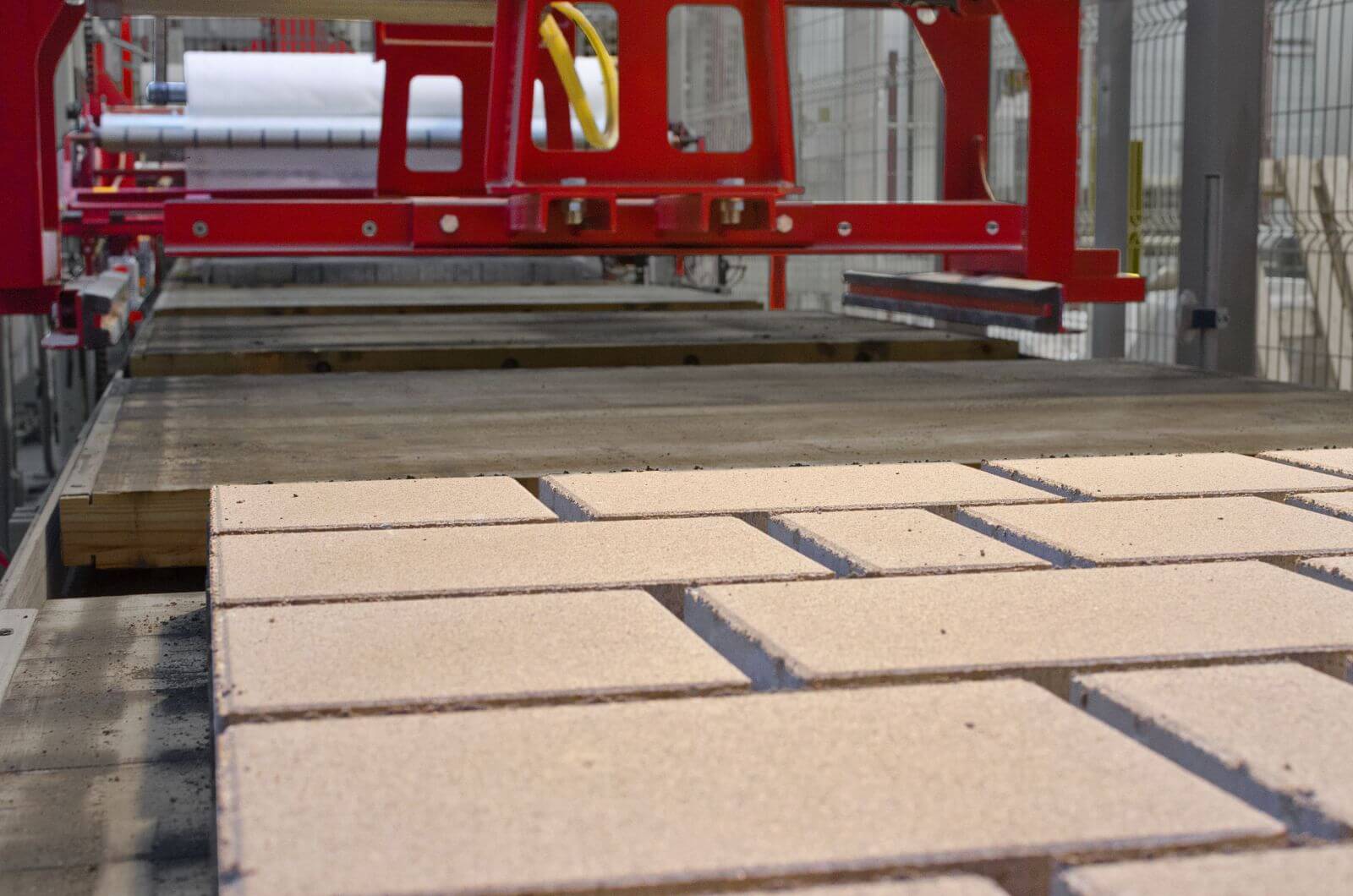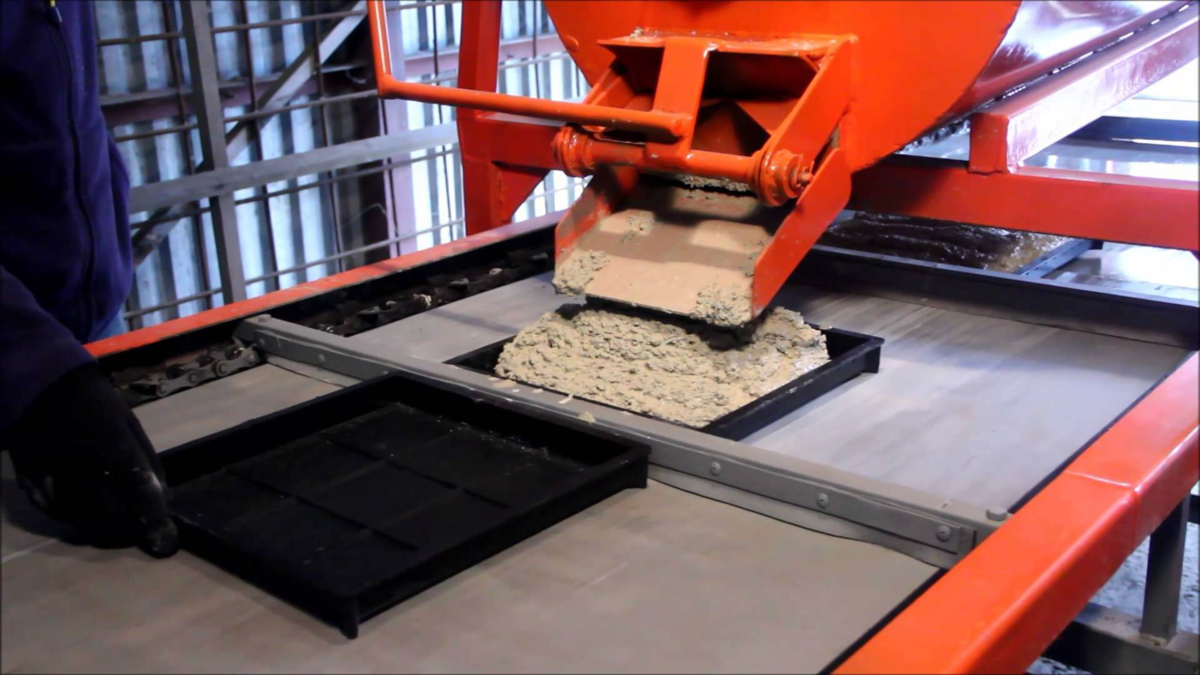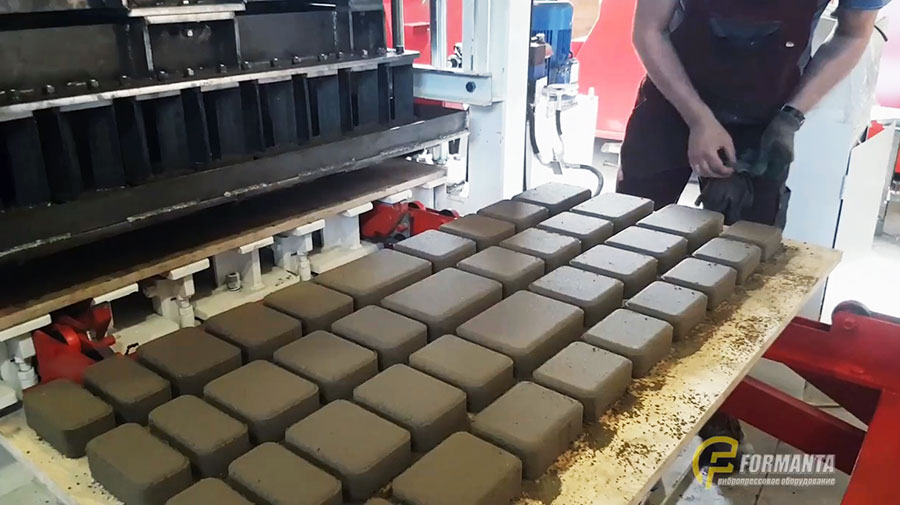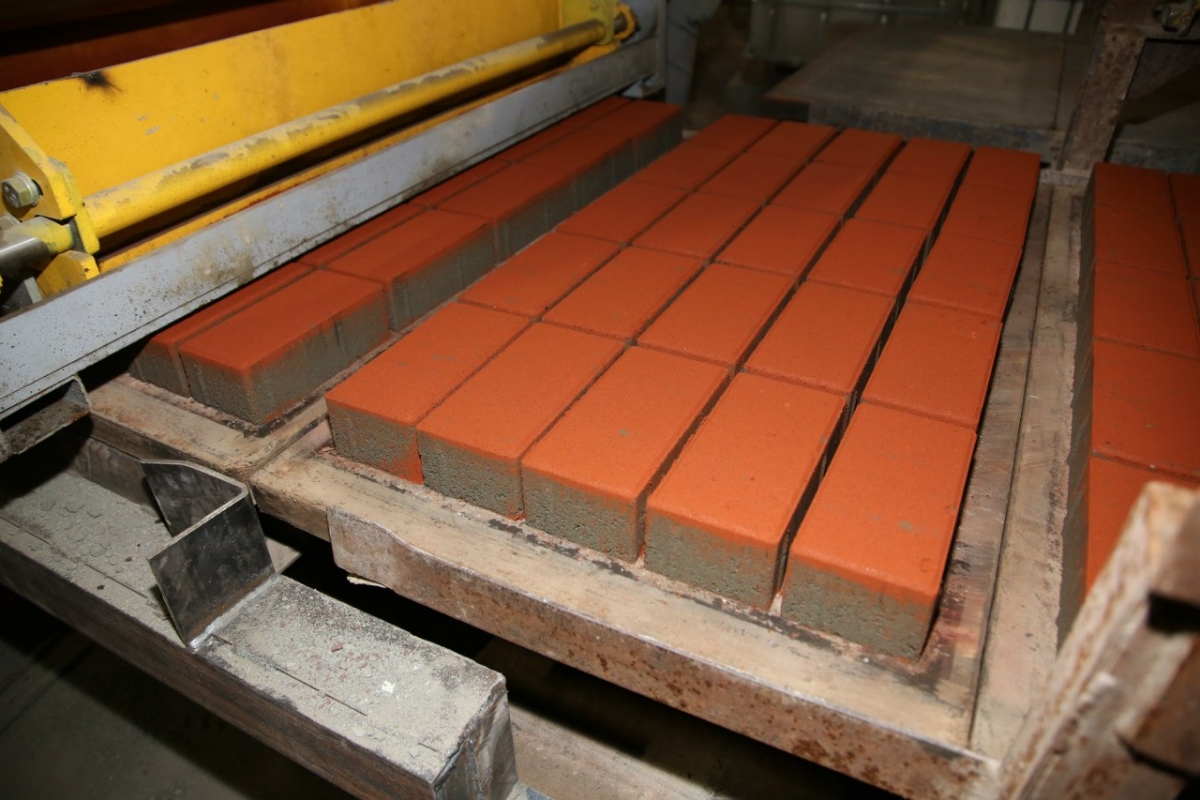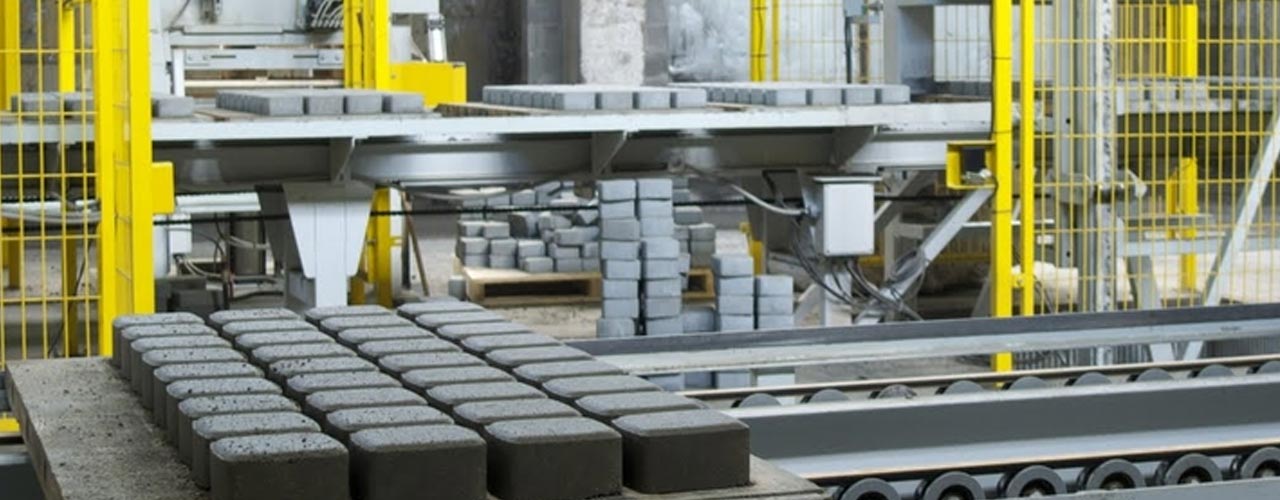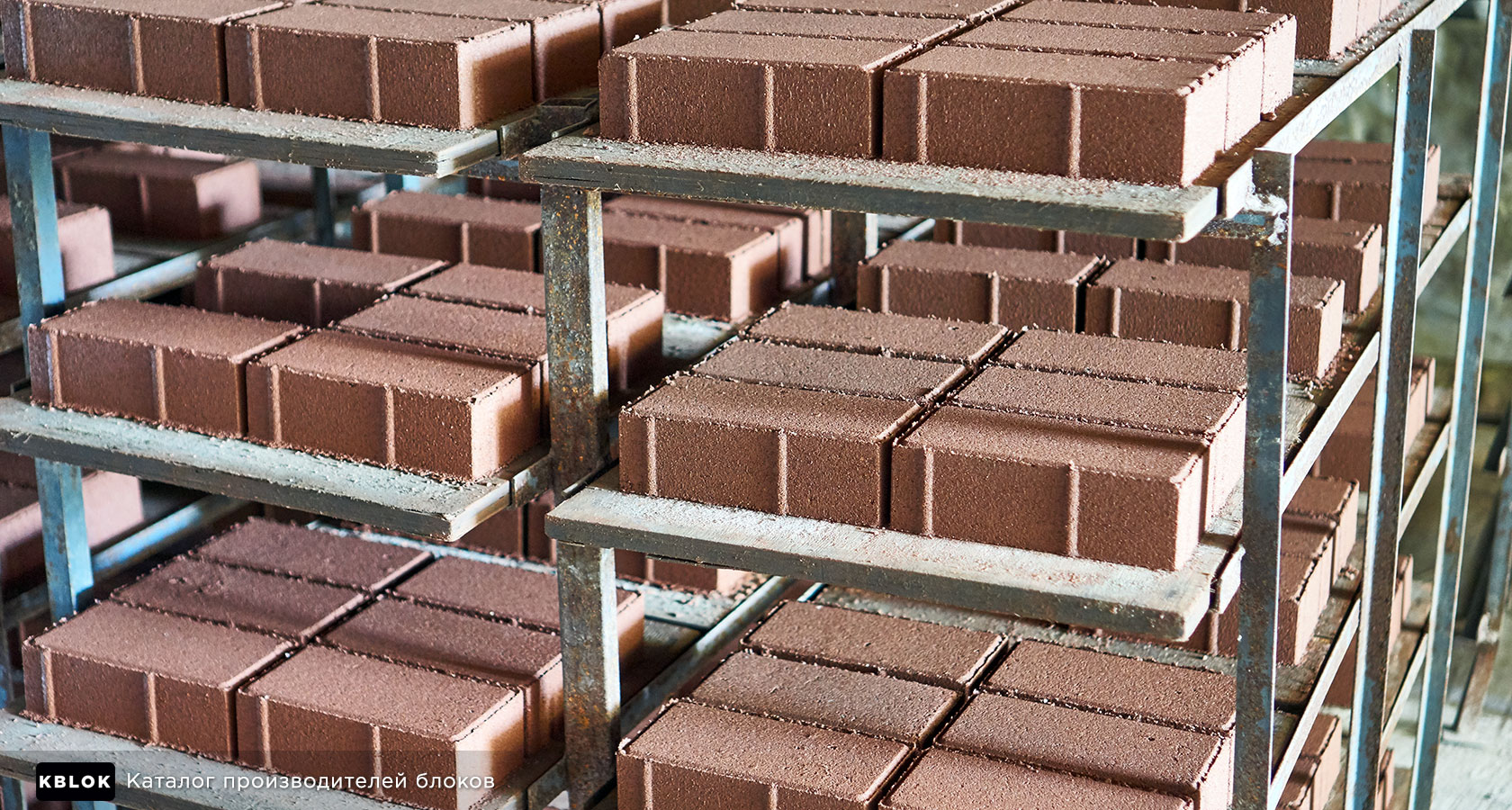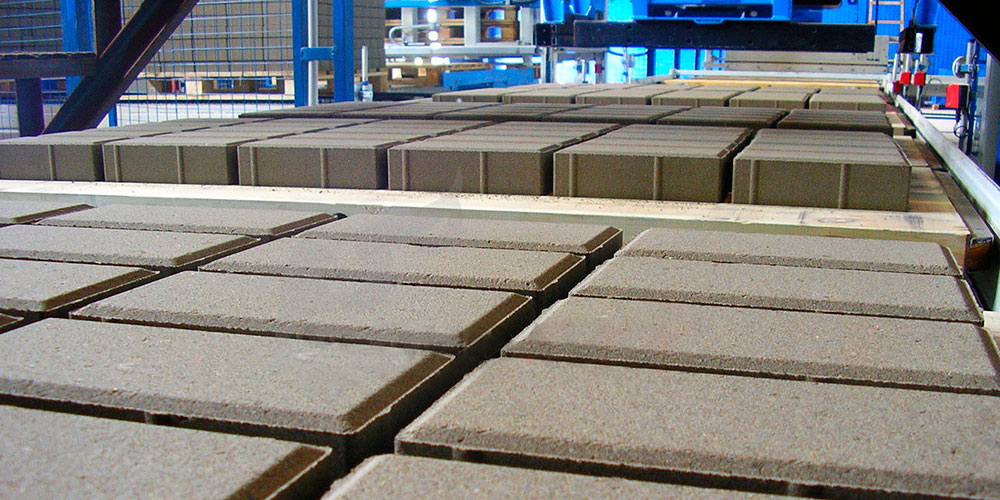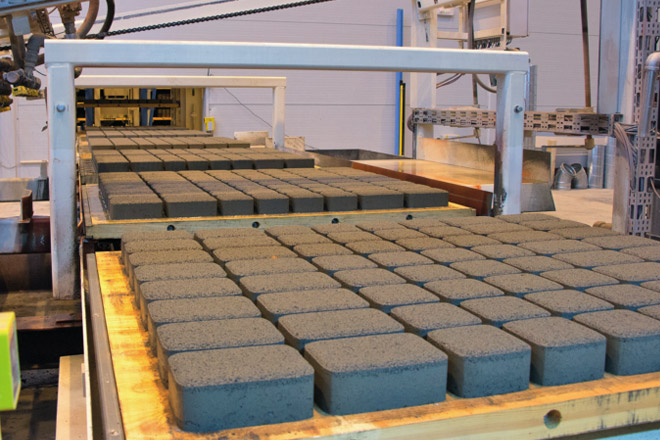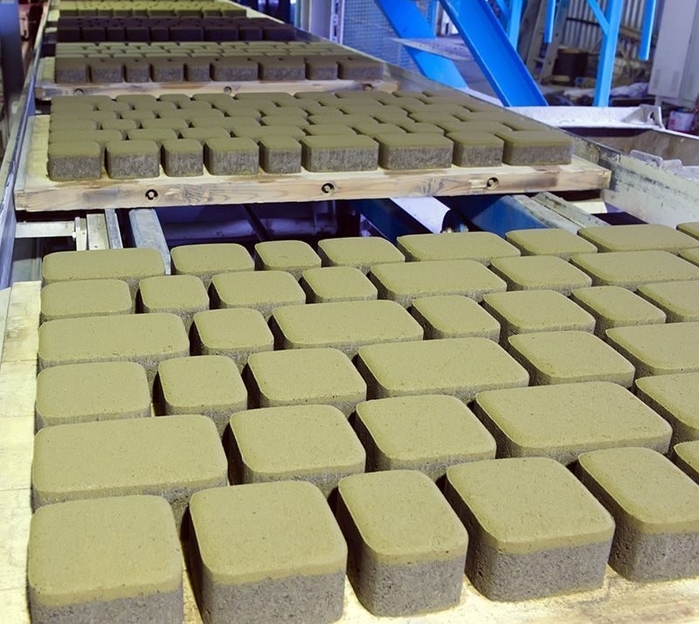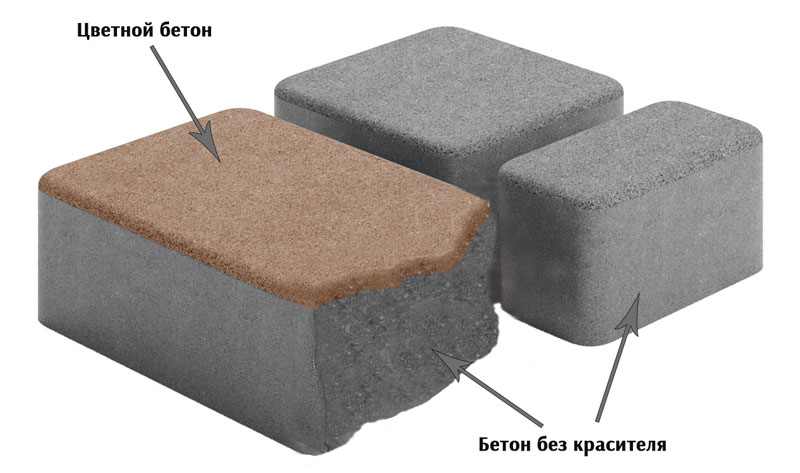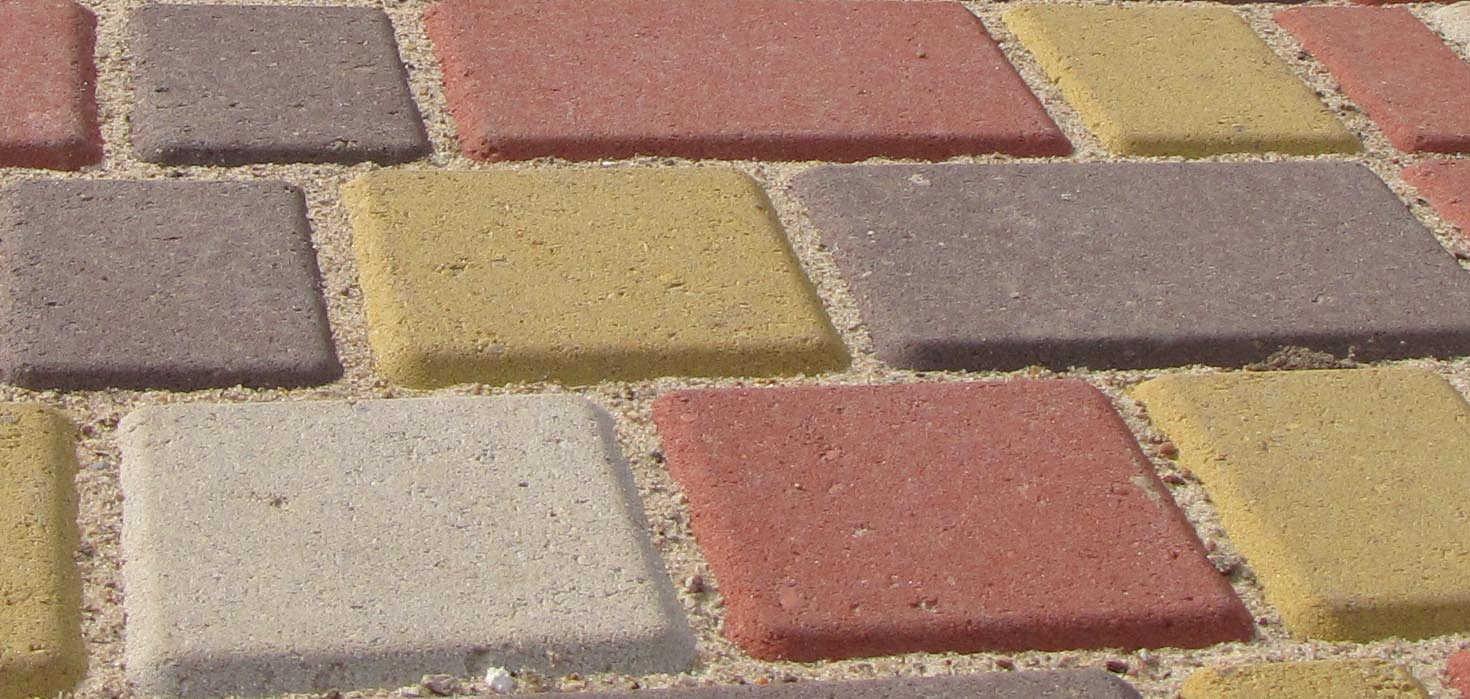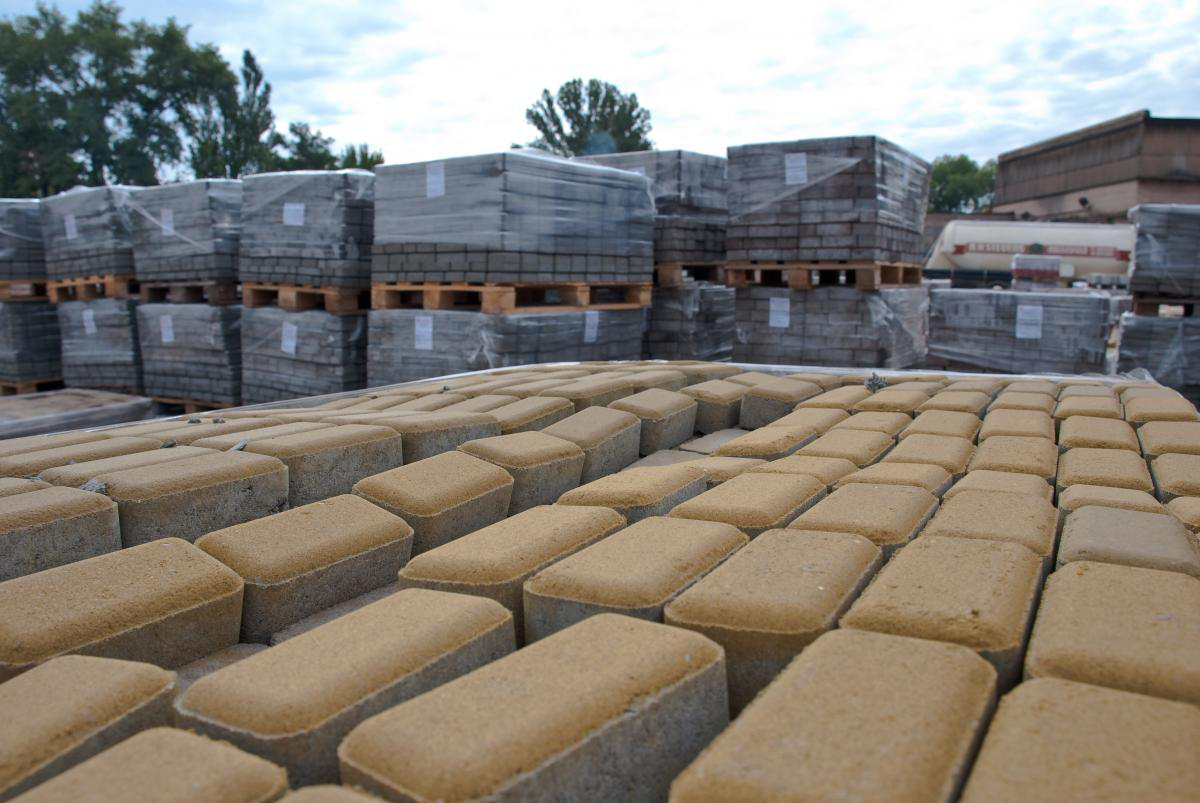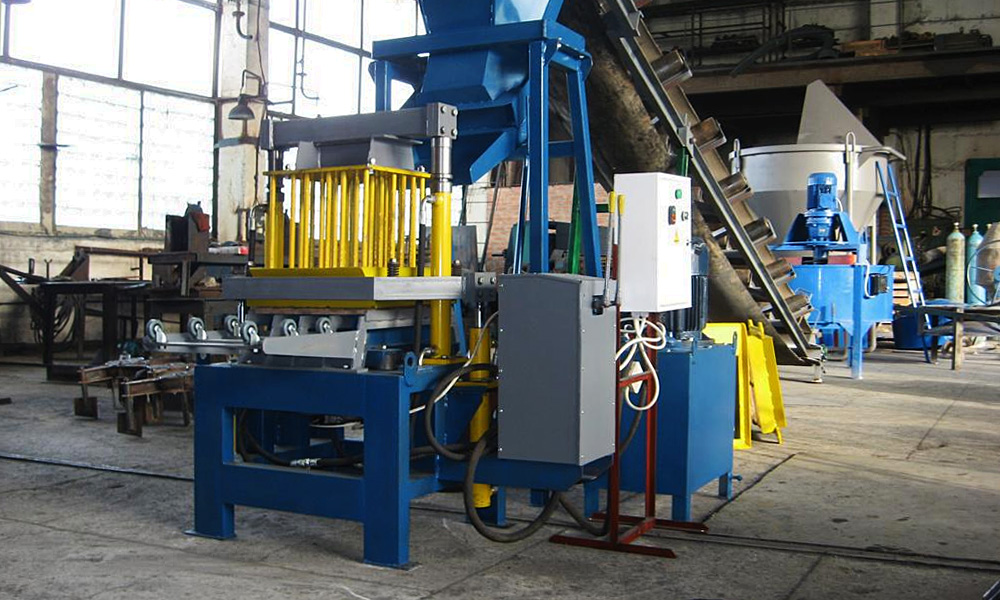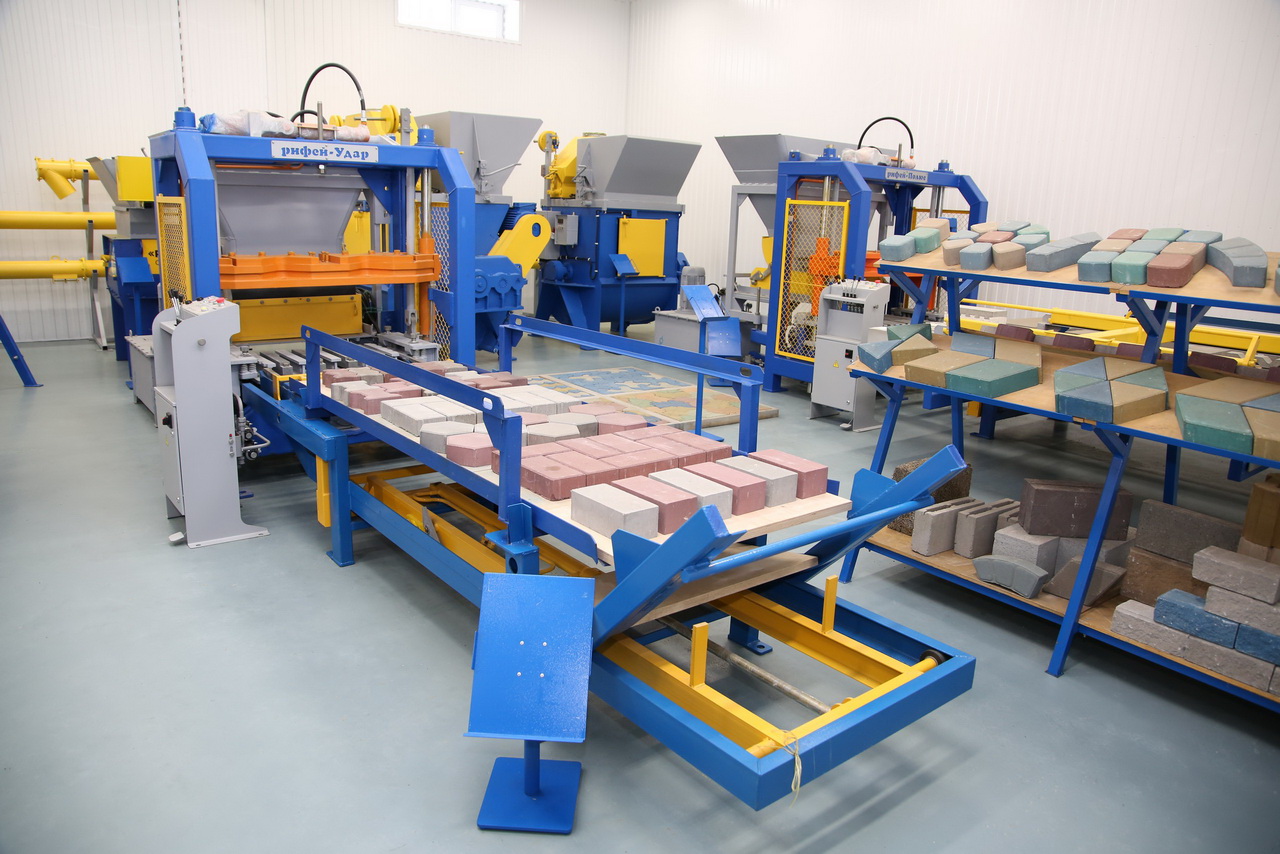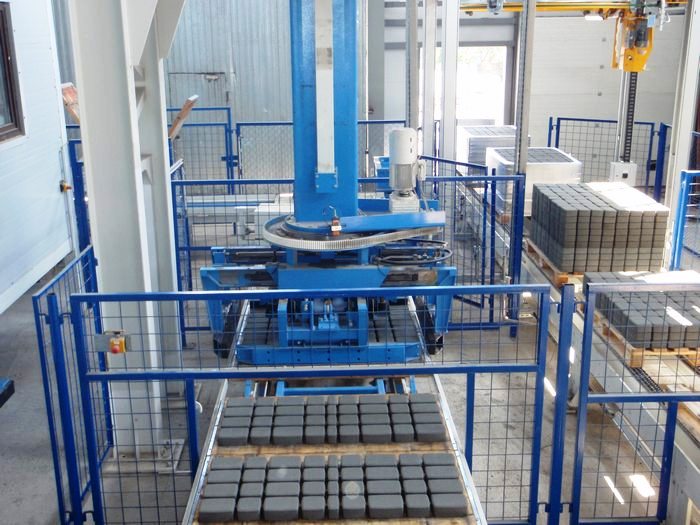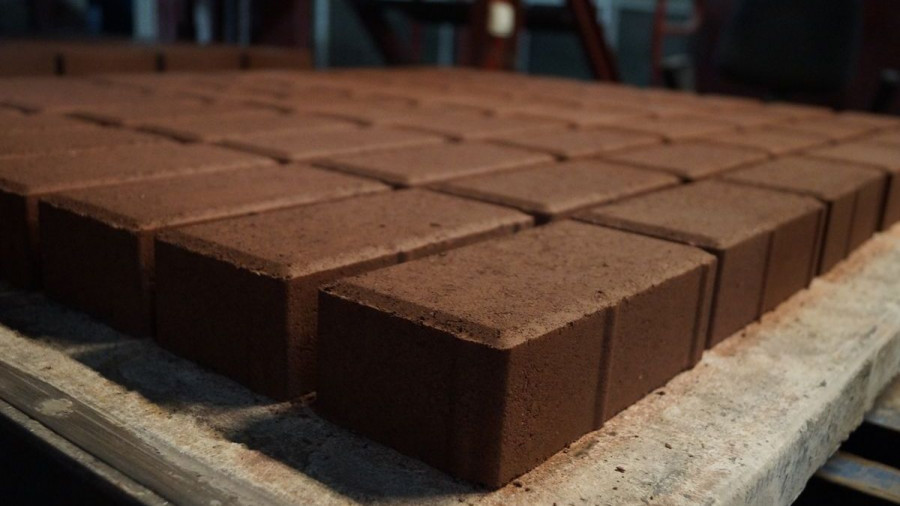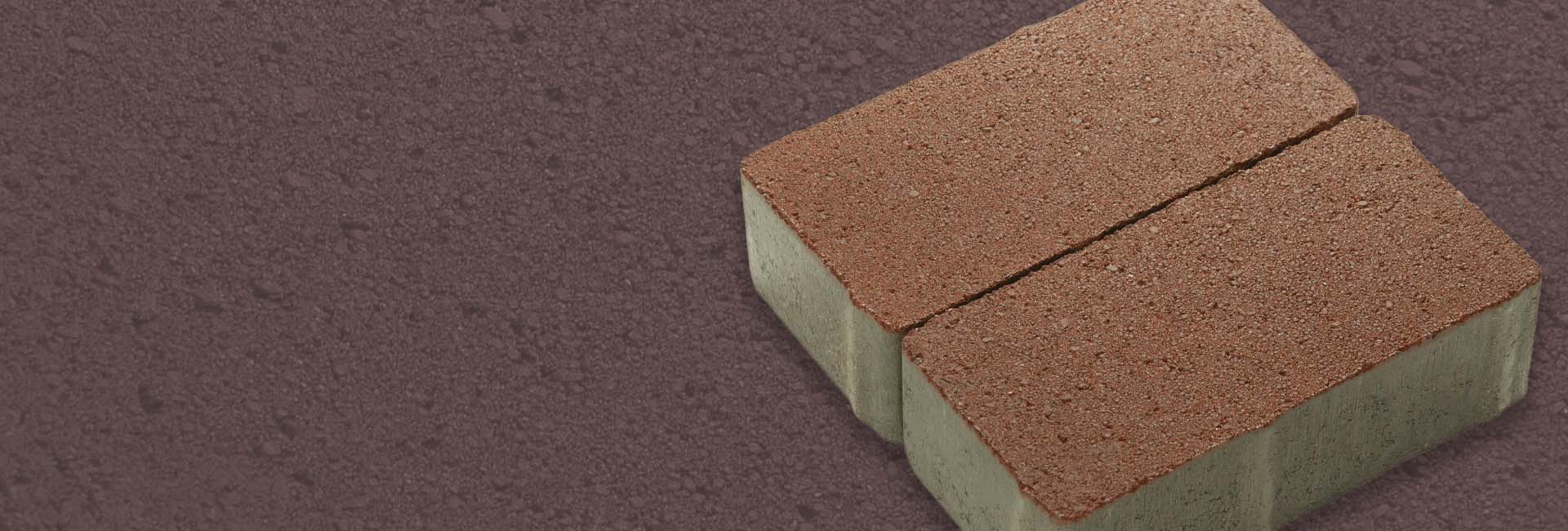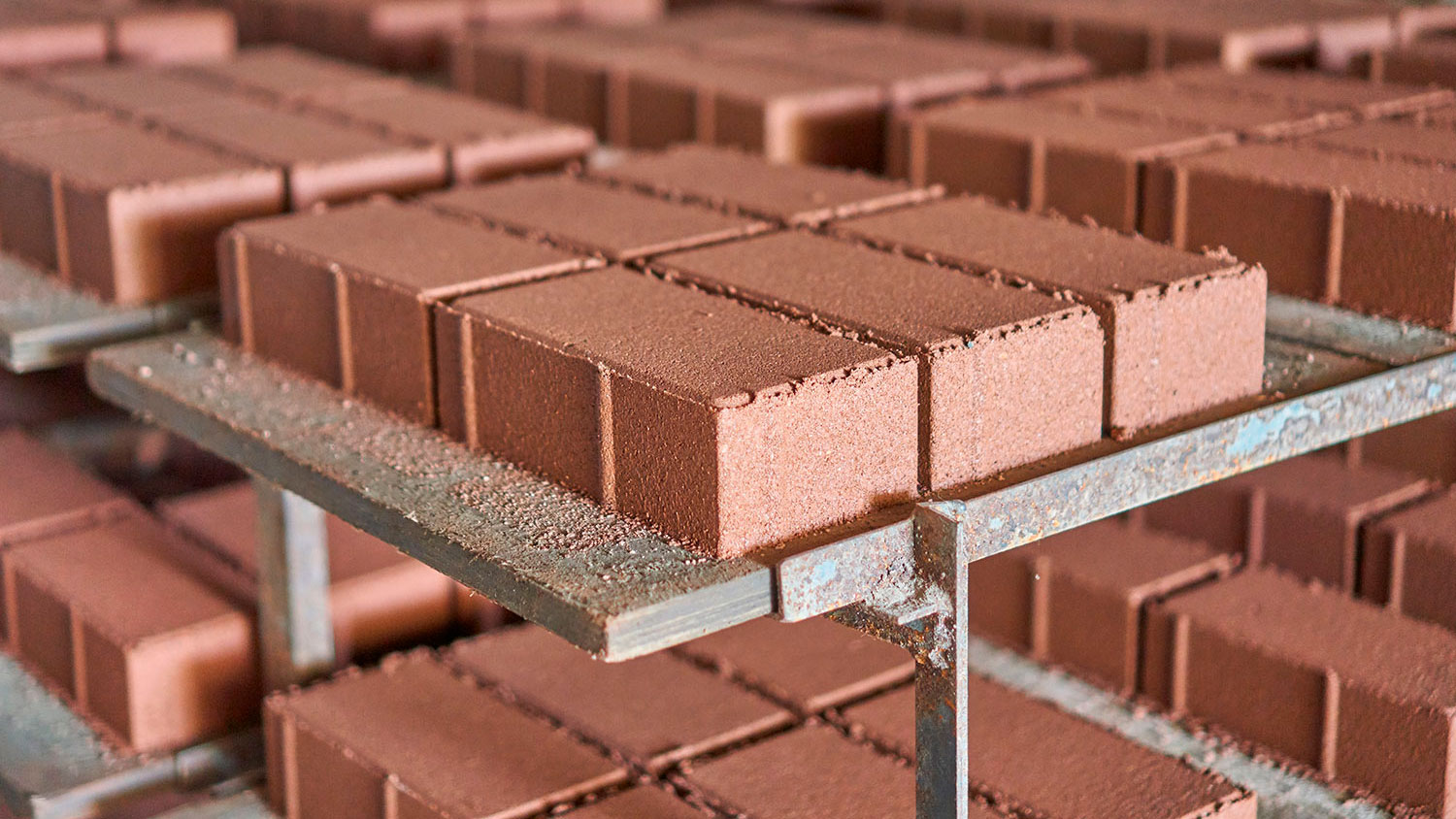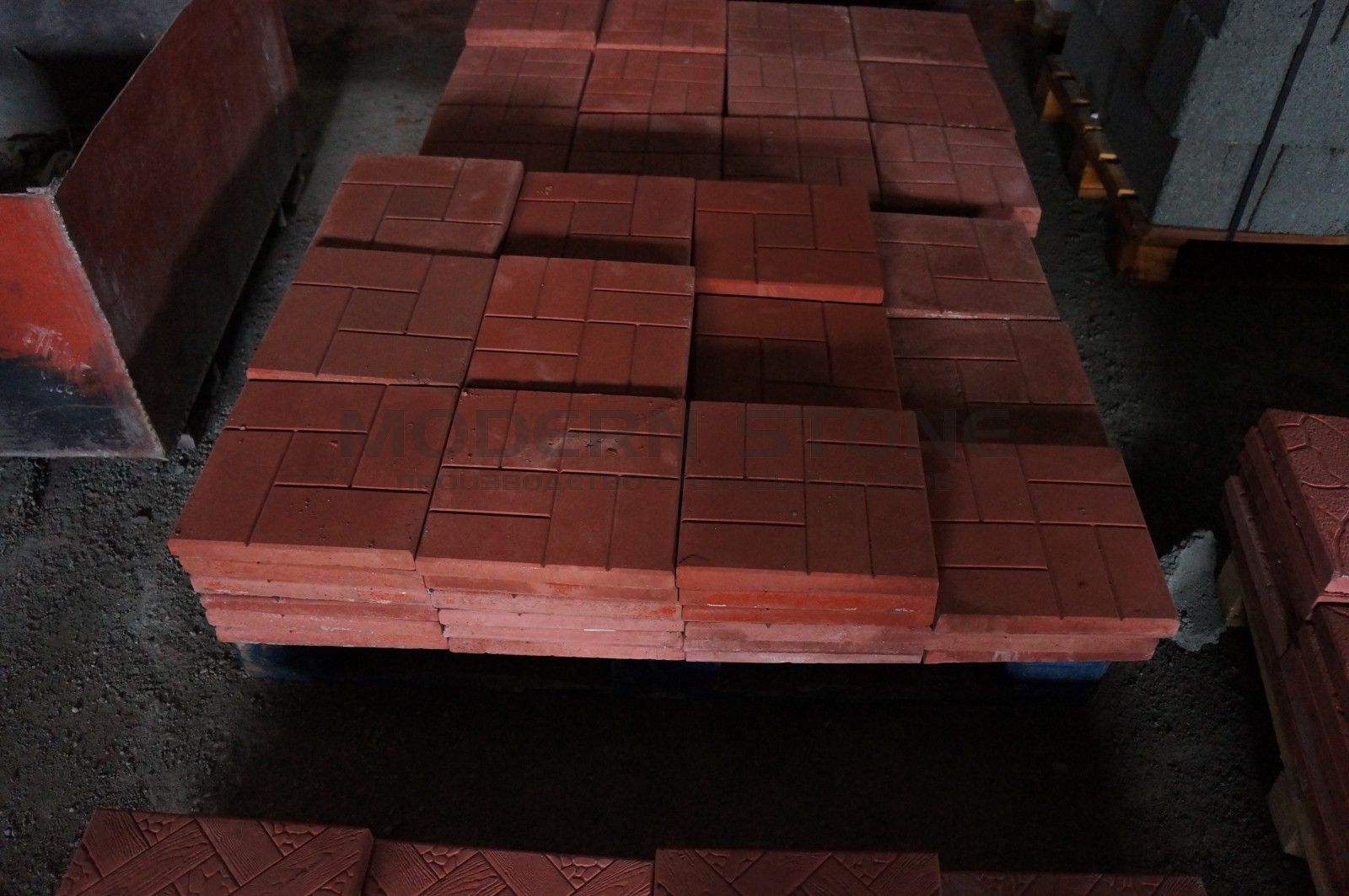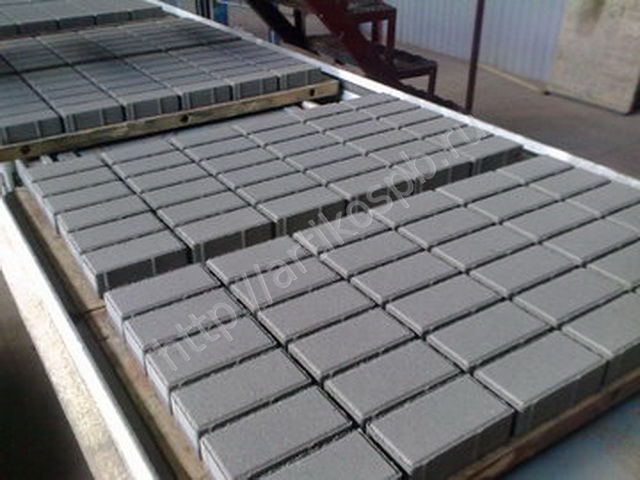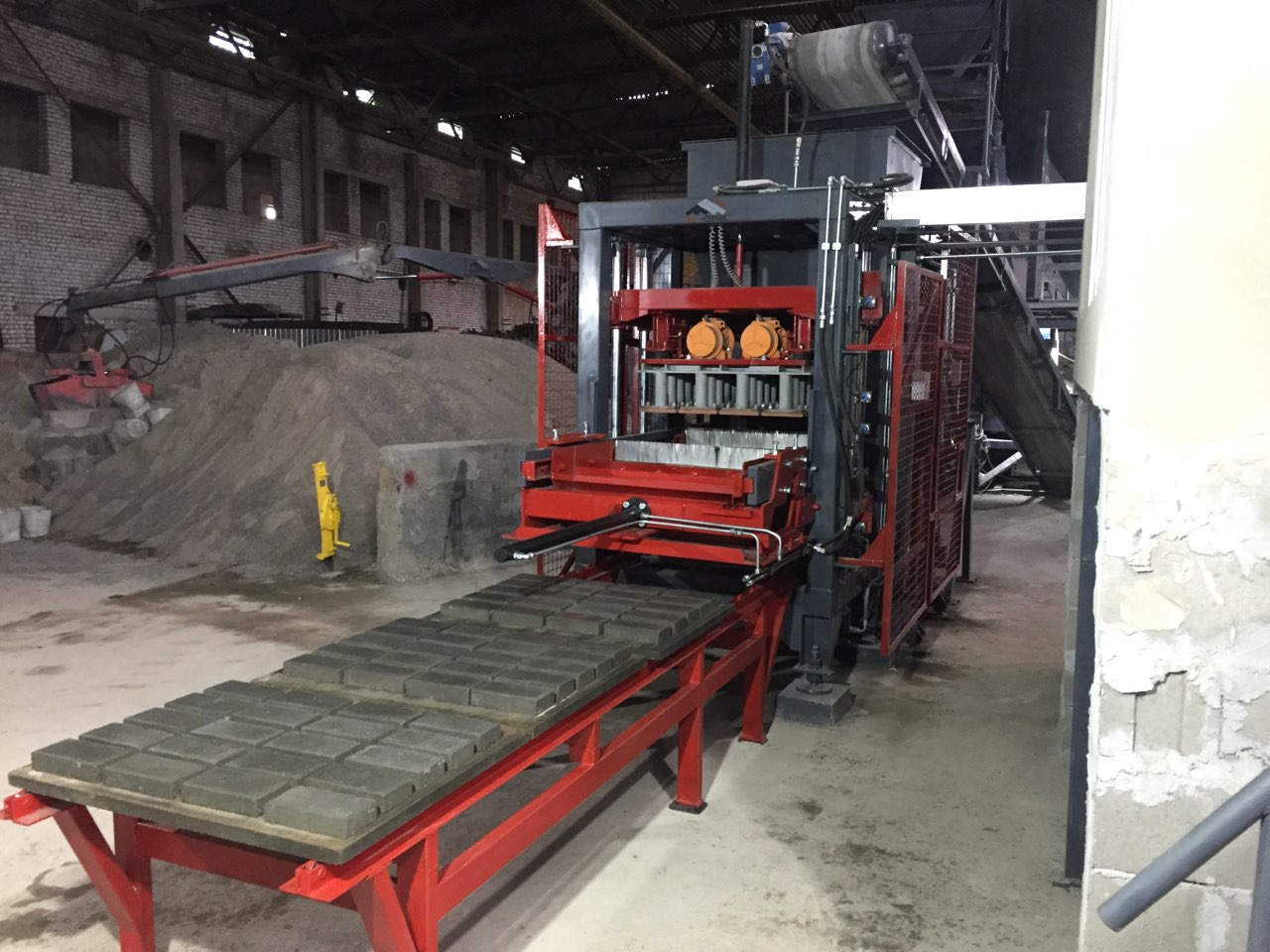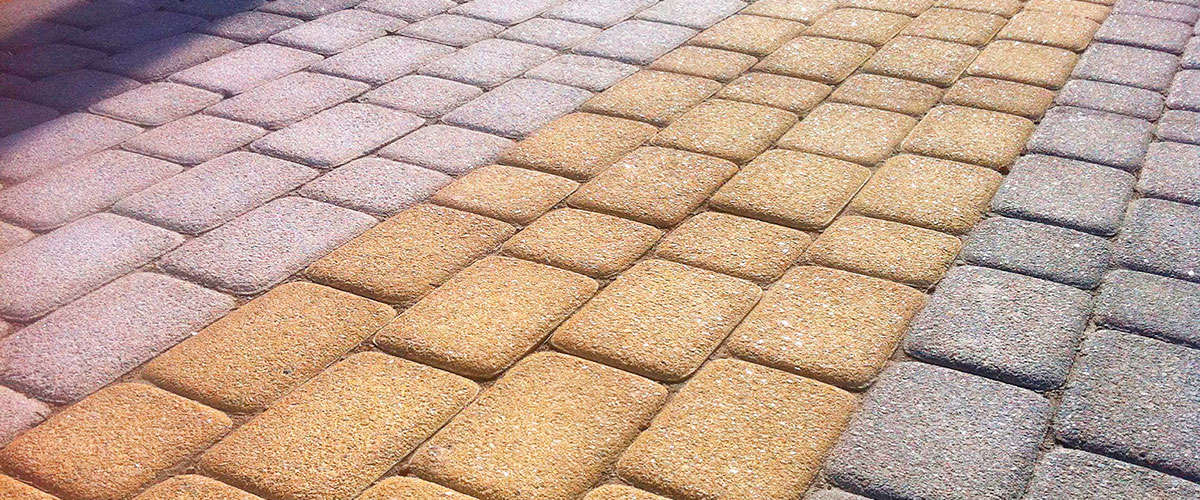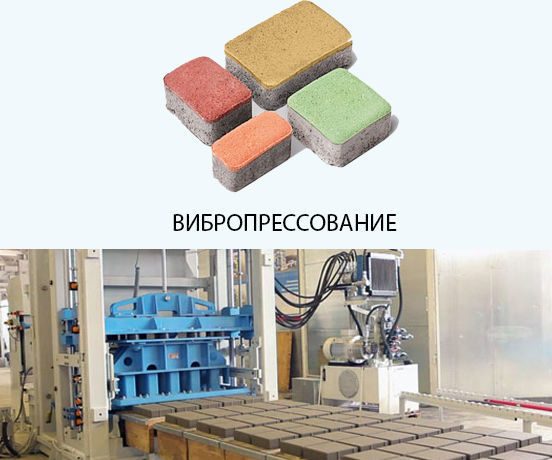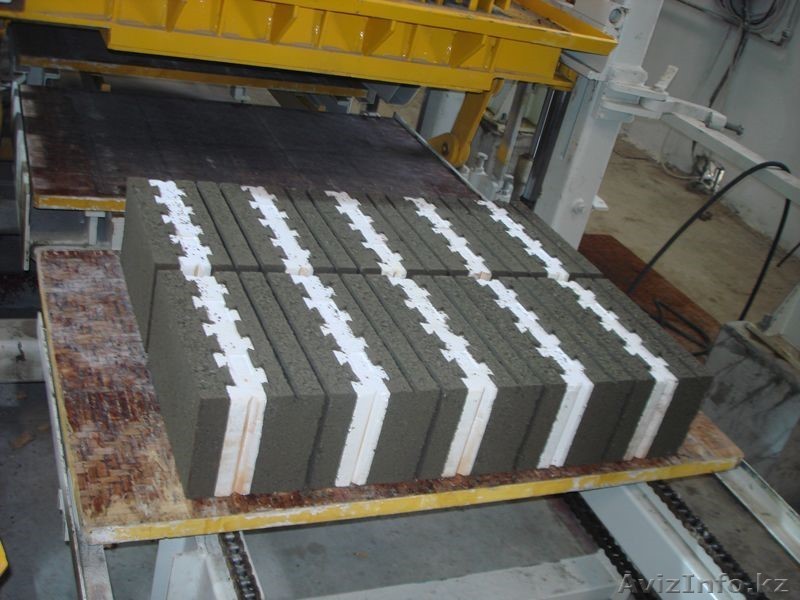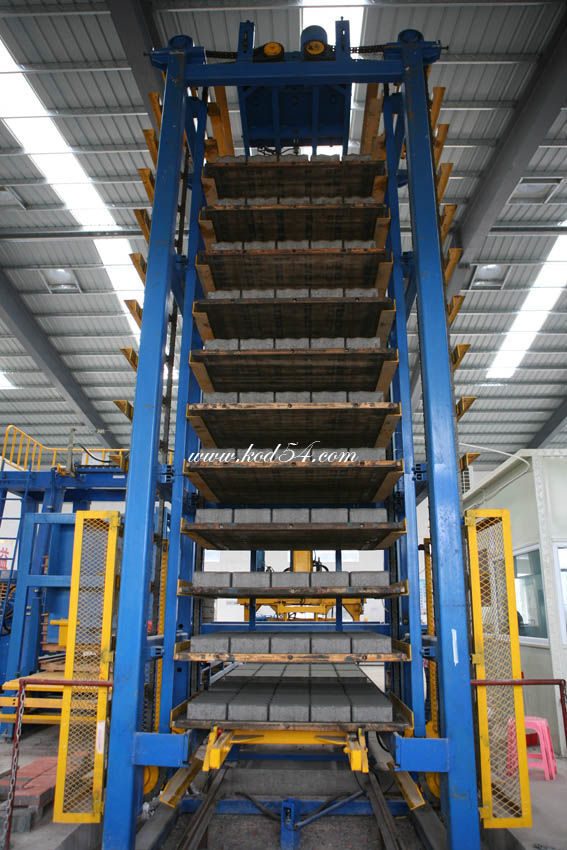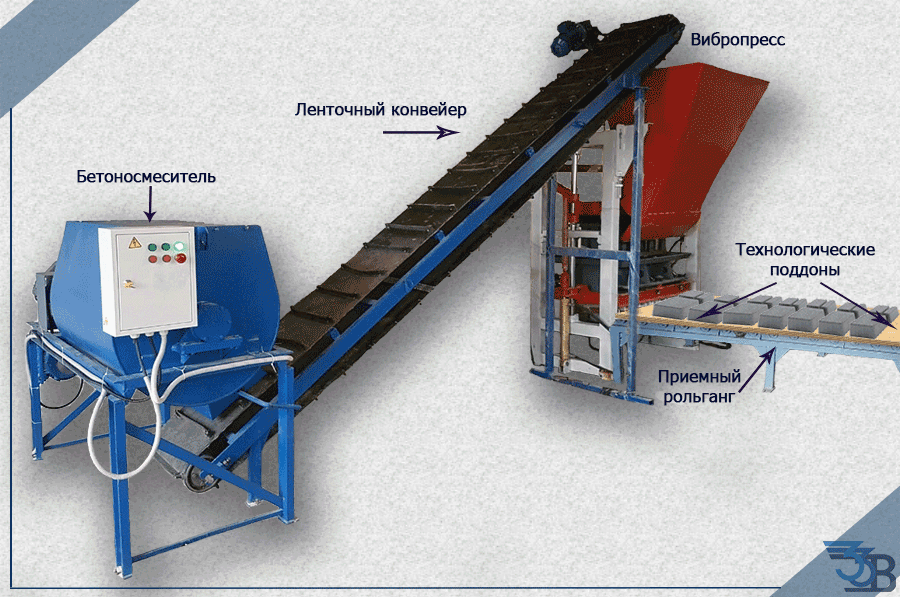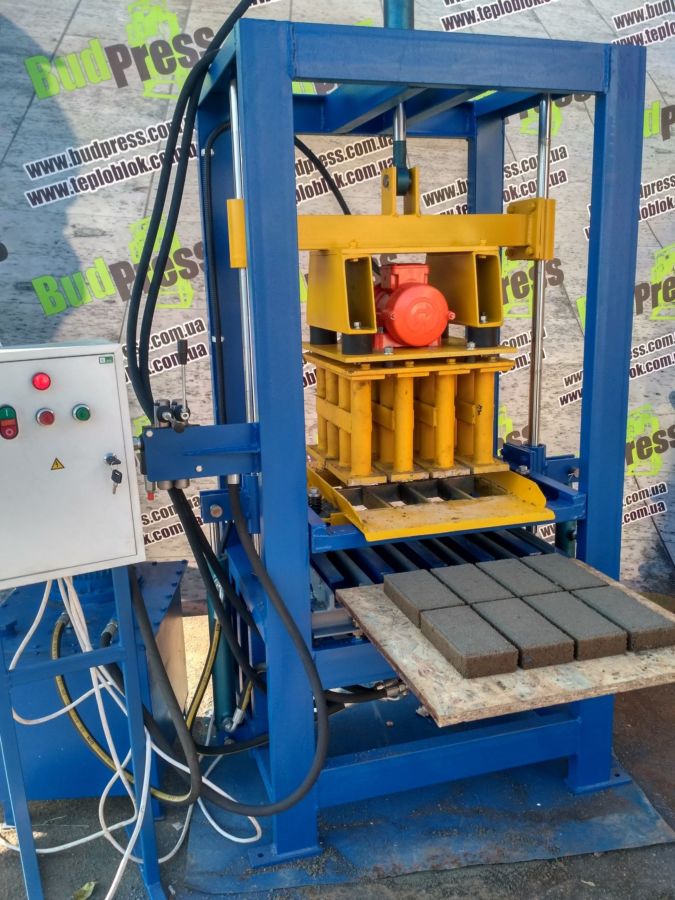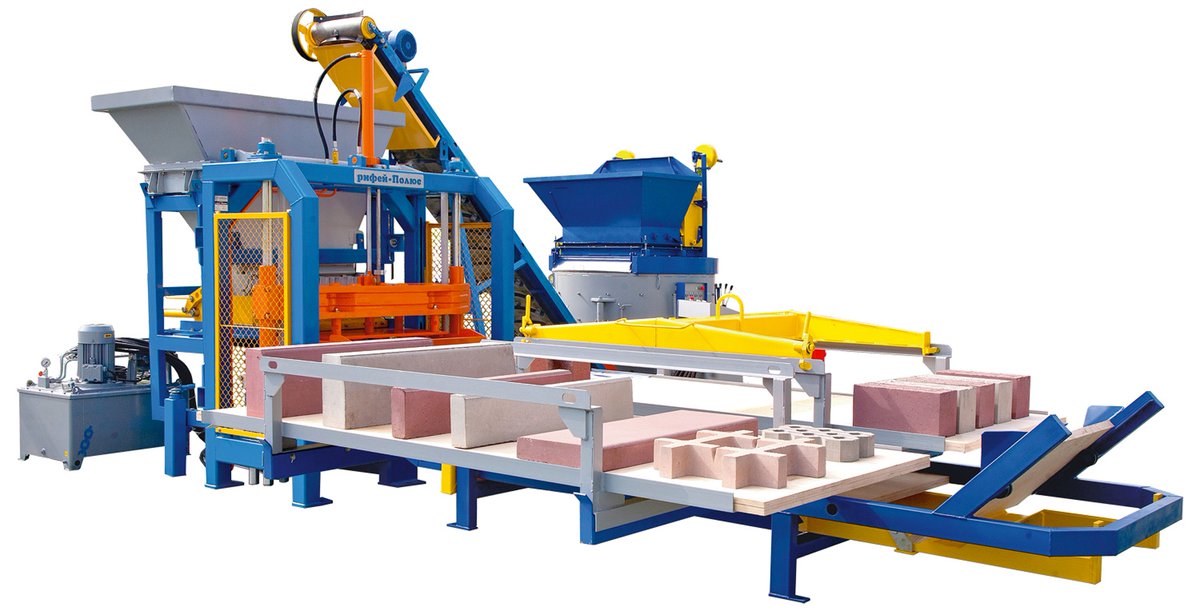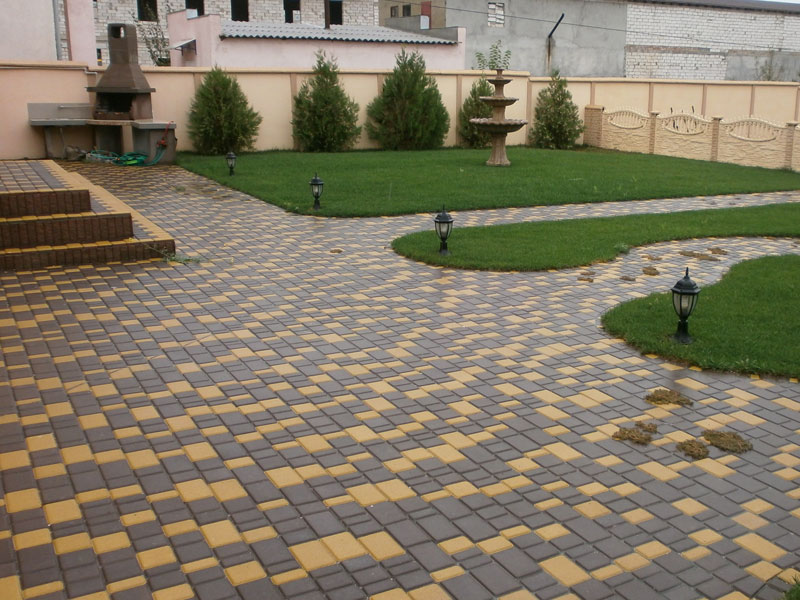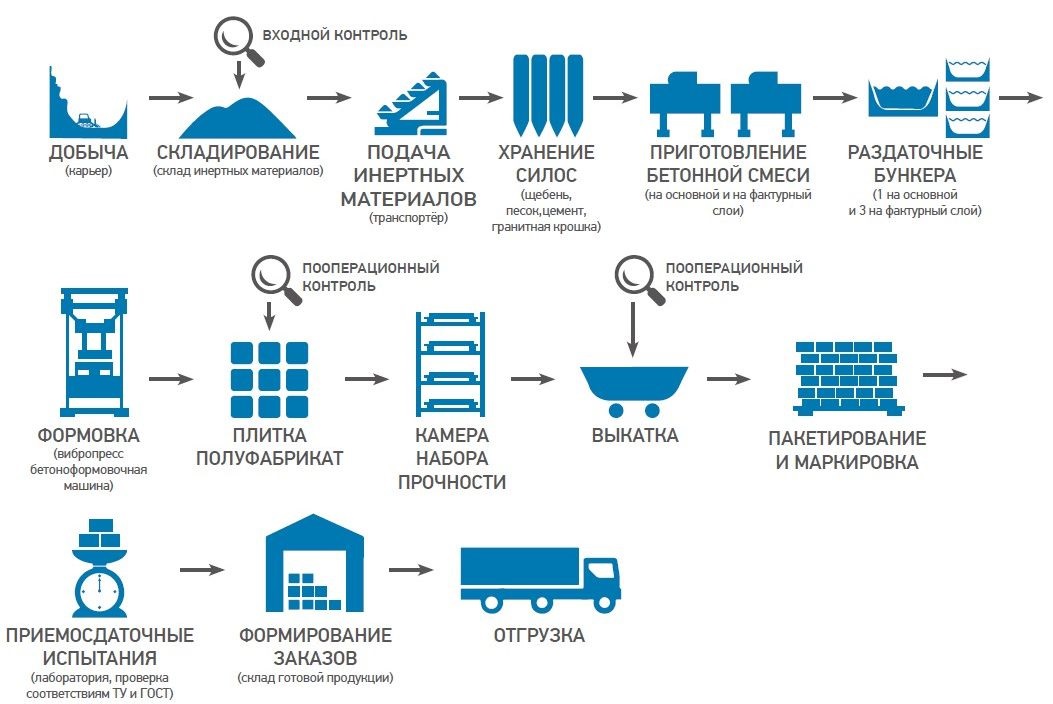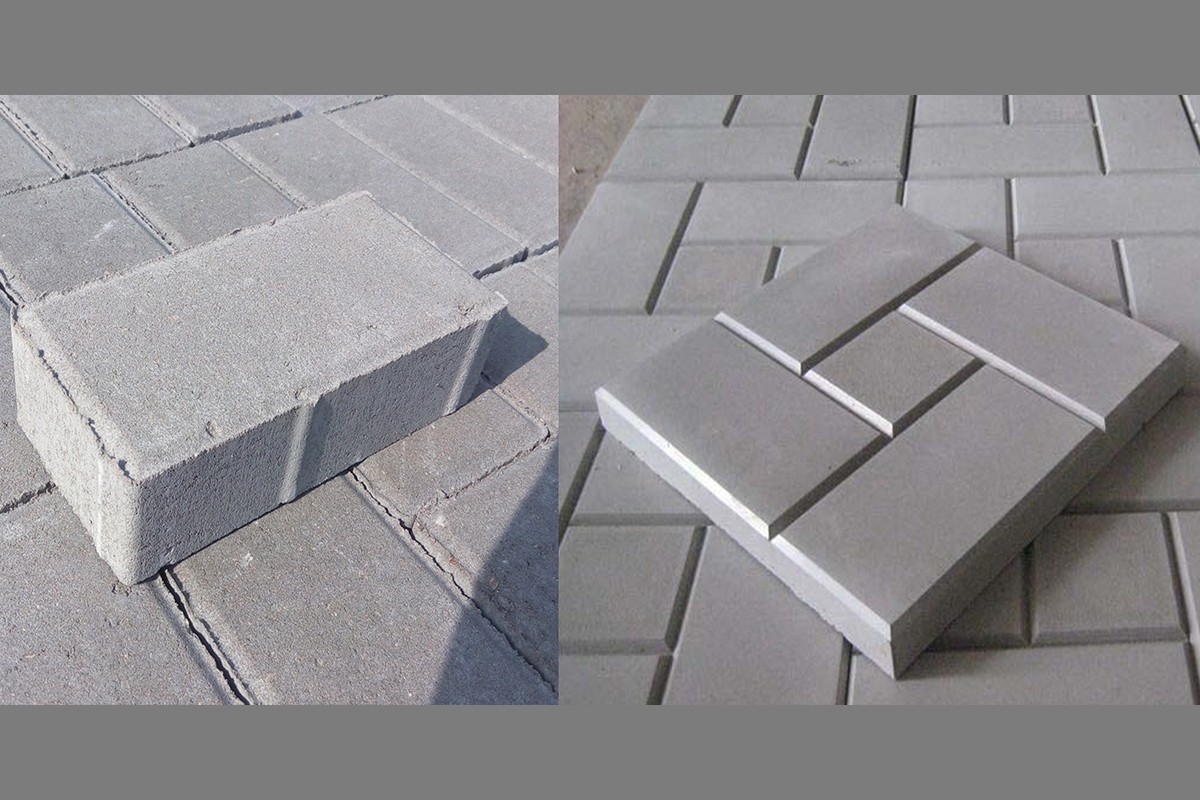How does the water-cement ratio affect the characteristics of the tiles, a way of visual inspection
SerdocFORUMHOUSE member
There are many nuances for vibro-pressed as well as vibrocast tiles: if the volume of water is exceeded during the production of vibrocast tiles, the tile will collapse if all other standards are observed. And the production of vibropressed requires a rigid DSP and excess water leads to sticking in the press, and a drier mixture leads to destruction. A tile made from a dry mix absorbs water very strongly and dries for a long time, and with the maximum possible amount of water, on the verge of sticking, it absorbs little and dries quickly like a natural stone. These two factors are very important and also affect the service life and appearance, which is well known to manufacturers.
Elena Maslova
This is indeed the case. It is necessary to correctly select the water-cement ratio for any method of paving slab production. However, in the case of vibrocompression, this nuance is limited, the production process is automated, any mixer is equipped with humidity sensors, the dosage of water consumption is regulated by a hygrometer. In the case of vibrocompression, it is necessary to obtain the maximum possible moisture content of the concrete mixture, which is visually assessed by the criterion of the formation of "scratches", "broaches" along the lateral surfaces of the product.
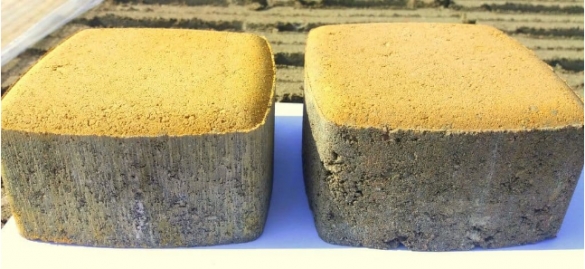
In the photo on the left - tiles with optimal moisture, on the right - from a dry mix
Vibro-pressed or vibrated paving slabs - which one to choose?

When choosing paving slabs, the consumer first of all pays attention to the operational characteristics, the appearance of the paving stones, the final cost per square meter of the roadway. It turned out that vibropressed tiles are ahead of vibrocast tiles in all respects, except for cost
It turned out that vibropressed tiles are ahead of vibrocast tiles in all respects, except for cost.
- The technical characteristics (frost resistance, strength, total service life) of vibropressed tiles are much higher than those of a similar model made by hand.
- The performance characteristics (wear resistance, durability, abrasion resistance) of pressed tiles are much higher than those of cast tiles, which makes it possible to use vibropressed paving stones even for the design of roads for light vehicles.
- The roughness of the outer surface is a significant advantage of vibro-pressed tiles from the point of view of safety for pedestrians in the rain and in winter.
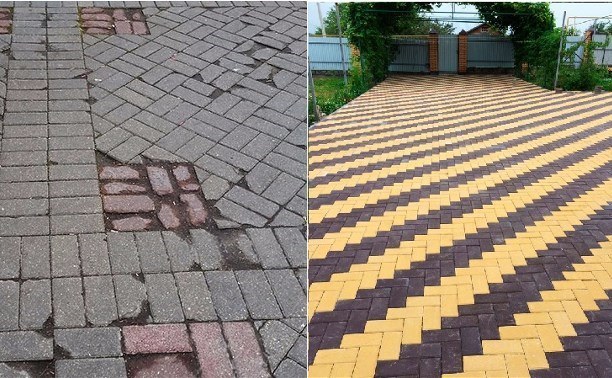
The statistics of roadway repairs shows that a road made of vibropressed tiles will need the 1st repair at least 25 years, while for a cast one the overhaul period is 5-10 years. At the same time, only 20-30% of the pressed elements of the road will require replacement, while for cast products this figure reaches 70-80%.
If we consider the cost of the roadbed as the main criterion for choosing the type of tile, then vibrated tile comes out much cheaper, since the cost of a unit of production includes overhead costs for the purchase and operation of automation.
Advantages of the method of vibrocompression of products
Subject to the observance of the recipe of the mixture and all important stages of vibrocompression, it is more preferable and makes it possible to obtain tiles resistant to frost, high temperature, water, wear, which correspond to GOST 17608-91.
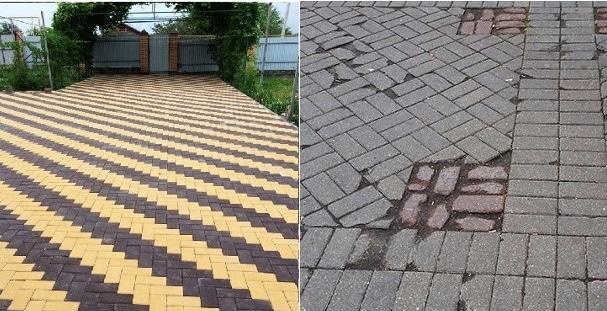
The main advantages of vibrocompression:
- A very high indicator of tile strength (M200-M400), subject to less cement consumption
- Getting a tile that is resistant to frost - the indicator is in the range of Mrz 200-300 cycles
- Significant savings on modifying additives, plasticizers
- Possibility to save on wages of employees (the process is automated at many stages)
- The ability to organize large-scale production, reducing overall costs due to double-shift work and a shortened technological cycle
- Possibility to equip a vibropress with different devices and devices in order to obtain different tiles, increase productivity
- Obtaining products with strictly designated geometric shapes, colors, sizes
- Rough tile surface - thanks to which it can be laid in urban areas, terminals, warehouses, braking and acceleration lanes, etc.
- Ability to process the surface of vibropressed tiles - the material allows bush hammering, polishing, grinding
Advantages of vibropressed paving slabs
In the process of producing paving slabs, two technologies can be used - vibrocompression and vibrocasting. The differences in these two production methods are quite significant, and they lead to a difference in the quality of the final product.
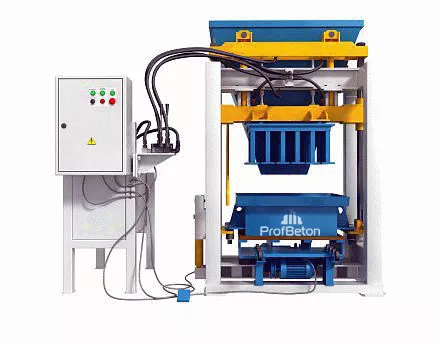
If you do not go into details, then the vibrocompression method is more technological and allows you to automate most of the operations. The shaping of products on a vibrating press is carried out under the control of the program, which leads to a minimum amount of rejects. Vibration casting is carried out for the most part using manual labor. It is rather difficult to control the quality of the products produced by this method.
But the main advantages of the vibrocompression method lie in the quality of the products obtained. Vibro-pressed tiles have a rough surface. It does not slip even with light icing. In contrast, vibrated products have a glossy surface, which is very slippery even after a little rain.
An important factor in favor of vibropressed products is a clear correspondence of shapes and sizes, which greatly facilitates the laying of such tiles. During vibration casting, products often have different thicknesses and curvatures. It is quite problematic to quickly lay such tiles.
In addition, a semi-dry mixture is used for vibropressing. This makes it possible to save expensive cement and increases the main consumer characteristics of the products. Vibro-pressed tiles have significant strength and frost resistance. During vibration casting, the cement consumption increases, and due to the high water-cement ratio, the frost resistance of the products is significantly reduced. As a result, vibrocast tiles are more prone to chipping and cracking.
In most cases, vibropressed products are laid on the basis of sand and rubble, while for high-quality laying of vibrocast tiles you have to use a concrete base. As a result, the concrete base collapses faster due to ground movements, which leads to the destruction of the tiles. As a rule, it is no longer possible to reuse vibrated tiles.
Vibrocasting and vibrocompression technologies allow the use of various dyes. In this case, in the case of vibrocompression, it is possible to manufacture tiles with a painted top layer. This makes it possible to reduce the cost of production. In most cases, colored glossy vibrocast tiles look more impressive, but the initial gloss quickly disappears during operation. Vibro-pressed tiles are distinguished by color fastness on throughout the entire period use.
- Characteristics of paving slabs to consider when buying
- Paving slabs in St. Petersburg
- Using the curb in road construction
- Variety of shapes and colors of paving slabs
- Paving slab laying technology
Existing manufacturing technologies
Tiles and paving stones, which you could see from neighbors, are made using only three technologies: casting into formwork, vibratory casting and vibrocompression.
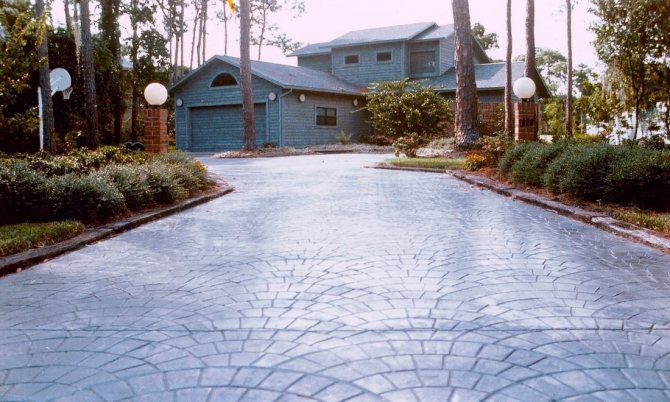
Stamped driveway with imitation paving slabs
There is also a technique for imitating paving slabs, when the texture is created by stamps on a wet concrete surface. At first glance, the walkway may look like a paved one, but in fact it is a monolithic concrete slab with all its disadvantages. Looking closely at the seams, it is easy to notice that they are inseparable from the slabs and are not able to provide water drainage into the ground. Therefore, if you liked the version with imitation seen in the photo, we recommend that you reproduce it in classical technology, from separate plates. In this case, your copy will last 3-4 times longer than the original.
Pouring into removable formwork
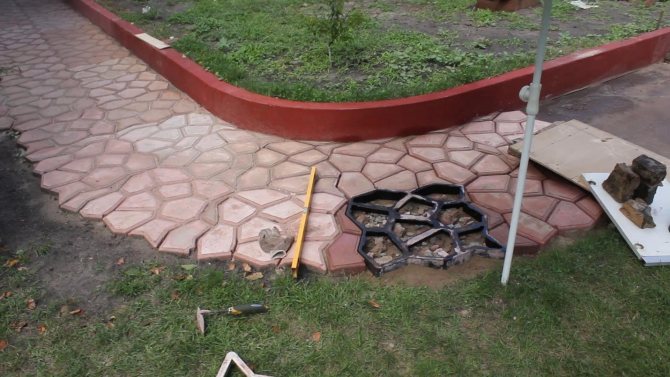
Production of paving slabs by pouring into formwork
The technology of pouring into a form-formwork is the simplest and least time-consuming method of manufacturing paving slabs. The products are cast directly at the place of use on top of the compacted soil, so there is no need to spend any effort on drying and moving the plates. Since the mold is removed while the concrete is not completely frozen, you can use only one mold and prepare small portions of the mortar in a bucket with a construction mixer (without a concrete mixer). The mold can also be partially filled, creating neat curves of the garden path.
But there are also disadvantages:
- the texture of the front surface of the slabs is always the same, since the shape is open and sets only the edge along the perimeter of each fragment;
- the concrete mixture cannot be compacted by vibration, therefore, more plasticizer should be added to ensure strength;
- despite the addition of binders, the service life of such a tile is several times less than that of a vibrocast.
It is quite simple to distinguish a path from such a tile. As a rule, it imitates the layout of a wild stone with irregularly shaped fragments, but the repetition of the pattern is easy to notice. Grass often grows in the seams of such tiles, since it is mounted directly on the ground without a sand and gravel cushion and often without backfilling.
Vibration casting

Vibrated paving slabs are the most common option
Vibrated slabs are the most common option for paving private areas. The easiest way to distinguish the product of this technology is by design. Neither pouring nor vibrocompression creates a complex tile shape and a small textured pattern on its surface. The front side of vibrocast tiles is usually more glossy, and the color is brighter than that of vibropressed tiles.
Among other advantages of this finishing material:
- the service life of the tile is several times longer, since vibration during casting expels air bubbles and enhances the water and frost resistance of the product;
- lower consumption of plasticizer (compared to pouring into the formwork);
- the ability to make durable high-quality tiles at home with minimal equipment;
- a wide variety of ready-made forms from different price categories.
Of the shortcomings, only a small thickness of the slab can be distinguished, which does not allow the finish to withstand high mechanical loads. On smooth tiles, the risk of slipping also increases, so we recommend that you select textured shapes for production.
Vibrocompression
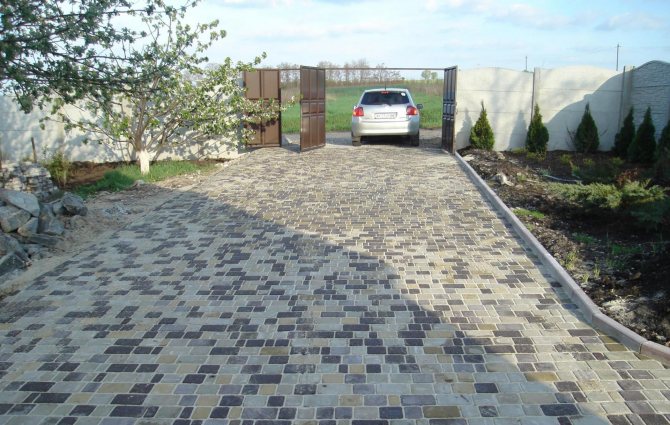
The paving stones in the parking area are vibropressed paving slabs
Vibrocompression is a complex technological process. Its main difference from vibration casting is that the solution in the mold is subjected to powerful blows from a special press. As a result, the density of the concrete-cement mixture increases by an order of magnitude; in its properties, the material is analogous to artificial stone. Therefore, it is it that is used for paving city sidewalks, paths in squares and parking areas in private territories.Due to its high density, the tiles are very frost-resistant, they can withstand up to 300 freeze / thaw cycles.
The method is most often used to produce paving stones rather than tiles. It is easy to distinguish it by its increased thickness and small size (it looks more like a brick than a tile). In addition, this material is usually rougher and paler in color. Since it is impossible to make a pattern on a separate fragment, to enhance the decorative effect, the paving stones are laid in beautiful ornaments (at home, you can use the cross-stitch pattern).
Among the disadvantages of vibropressed tiles, only the high price and considerable weight can be distinguished, which complicates transportation and installation.
Advantages of the method of vibrocompression of products
If you correctly observe the composition of the mixture prescribed by the recipe, do not violate the production technology, then the material obtained by vibrocompression will make it possible to obtain products that perfectly resist frost, moisture, high temperature and wear. The main advantages of vibrocompression are:
- good strength indicator with minimal cement consumption;
- frost resistance of the product;
- the ability to significantly save on the use of plasticizers and modifying additives;
- the ability to reduce the cost of wages, since most of the technological processes are automated;
- when organizing mass production, costs are significantly reduced due to a reduction in the production cycle and the organization of a two-shift operation;
- the ability to add other devices and devices to the vibropress to increase productivity and release tiles of different shapes;
- the resulting tiles have strict geometric shapes, they have a unified size, different colors;
- the rough surface allows tiling city sidewalks, public areas, warehouse areas, using it for acceleration and braking lanes of vehicles;
- the ability to perform additional processing of vibropressed tiles, since the products can be sanded and polished.
Comparison of characteristics
All types of tiles differ in manufacturing technology, so they have different quality characteristics. In the production of vibrocast tiles, manual labor is used, therefore, the influence of the human factor is observed. Product quality can be reduced if workers change the proportions of ingredients or otherwise violate the technology.
When producing vibrated slabs, a mixture of liquid type is used. Because of this, when excess moisture evaporates, small voids are formed. After laying the paving stones, water begins to penetrate into them already with the first rain. In freezing conditions, the ice breaks the slab from the inside, which reduces its strength.
Vibrocasting technology also differs in that the compaction of the solution after pouring into the mold occurs under its own weight.
The production of paving stones by the vibrocompression method differs in that enterprises use a semi-dry solution. This prevents the appearance of voids, contributes to an increase in the service life. The production is automated, so the human factor does not affect. Products are not formed under their own weight, using a vibrating press.
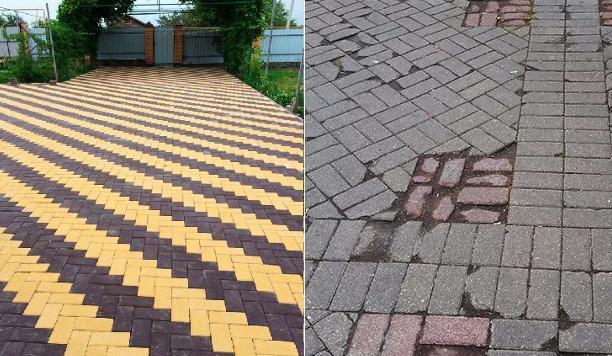
Strength
The products obtained by the vibrocompression method are durable. They are released from. They can withstand heavy loads of 1 cm² up to 400 kg. The mixture is compressed during the production process, it is affected by vibration. This leads to the fact that all the components are as close as possible.
The finished product has a finely porous structure. It is homogeneous, which increases the strength of the paving stones, making the service life longer.
The strength of the tiles obtained by the vibrocasting method is lower. The layers have a heterogeneous structure. The upper layer is stronger than the lower one.Because of this, after several years of operation, you can notice that it has lagged behind the foundation.
The strength of the paving elements depends on the good faith of the manufacturer. If he saves on materials, the strength index will decrease.
Life time
Vibro-pressed plates will last at least 25 years. Average service life of vibrocast is 5 years. But often the coating is destroyed after 2-3 years. This means that the production technology was violated, the company was saving on materials.

Design
The number of forms of vibropressed paving stones is limited, there is a limitation on the number of colors. But this is offset by the fact that there are many styling options. Vibrocasting products can be of any color. The palette is not limited by anything, so you can embody all the ideas of the designers.
Surface texture
Vibrocast paving stones have a beautiful, smooth surface. But when the temperature drops below zero, it becomes slippery. It is not safe to walk on it even in the rain. does not have these drawbacks, the shoes adhere well to the surface even in frost.
Geometry
During production by the method of vibrocompression, the solution is poured into molds automatically. The volume of the mixture is precisely dosed, therefore finished products have a clear shape and sizes. After laying them, even over a large area, a flat surface is obtained.
During vibration casting, workers manually pour in the solution; during the production process, silicone molds are used. The finished products are irregular in shape. When laying them, gaps and cracks are formed, so it is difficult to make the surface of the site even.

Price
Vibrating tiles are cheap. But after a few years, some of the paving stones will collapse, so it will have to be replaced.
To avoid constant repair costs, it is better to purchase vibropressed plates. They are more expensive, but do not require constant renovation.
Manufacturing process
With vibrocompression, the production process is automated, manual labor is not used in the production process. The products are of high quality.
During vibration casting, manual labor and workers are indispensable, it is used at all stages.
Production volumes and terms
The difference between the vibropressing method is that the enterprise can produce large volumes of products in the shortest possible time.
When using vibrocasting, they are several times smaller, products are dried for a long time in molds. The number of finished paving stones depends on how many workers work at the enterprise, and on the equipment of the shops.
Waterproof and frost resistance
Vibro-pressed boards do not absorb water well. They are frost resistant, withstand more than 200 freeze and thaw cycles.
Vibrated products absorb water more strongly. Frost resistance of products is several times lower than those obtained by vibrocompression.
Advantages of vibro-pressed tiles
MadbotFORUMHOUSE Member
I want to put paving stones under the parking lot. I read a bunch of sites and topics. I did not understand for myself:
Vibrocasting is still less strong than vibropressed?
Does a vibrocast have any operational advantages? Or just brighter colors?
The builders say that it is easier to wash off the dirt with the vibrocast with the same Karcher, plus, they say, they have had this for many years and nothing. But I see that in the city it is often split (albeit vibropressed too). In principle, I would not say that I definitely want a "glossy" surface, therefore, can I stop at a vibropressed one and not take a steam bath? But for myself I want to figure out, maybe the vibrocast has some advantages (in addition to the appearance, which someone likes).
Elena Maslova
1) Vibro-cast tiles are less strong and dense than vibro-pressed tiles, because:
- A) there is no crushed stone in it (the main component responsible for the strength and durability of the concrete of the product).
- B) during its production, a high water content is required, which, when the concrete mixture hardens, evaporates and leaves behind large pores and communicating capillaries. During winter operation, they are saturated with precipitation water and salt reagents, water expands during freezing and concrete collapses. In the case of vibrocompression, the resulting pores in concrete are scattered and closed, water cannot penetrate into them from the outside.
- C) with vibrocasting technology, the concrete of the product is compacted under the influence of vibration, with the technology of vibrocompression, compaction occurs simultaneously under the action of both vibration and punch pressure, the concrete density of a freshly formed product is significantly higher.
- 2) Only bright colors. In general, it is believed that vibrated paving slabs are more attractive to the buyer due to the variety of shapes and colors in full paint. At the maximum permissible dosage of dye, colored vibrocast tiles are duller due to the high water-cement ratio during production. Therefore, manufacturers add more pigment to achieve brighter and richer shades.

However, few people know that high dosages of coloring pigment adversely affect the strength of the finished product.
In addition, in the technology of vibrocompression, a high-quality granular pigment began to be used, which has high light resistance, does not fade at all, can be used in low dosages, while a bright, beautiful product is obtained.
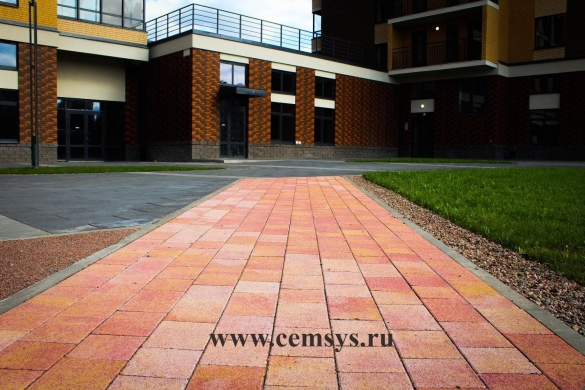
- 3) Of course, dirt is washed off from a smooth surface much better, but with a karcher you can perfectly wash off dirt from the surface of vibropressed tiles. Cracked vibropressed tiles can indeed be found in urban public spaces. This is due to the fact that there are two methods for the production of vibro-pressed tiles - single-layer pressing and two-layer pressing. With a single-layer method, the main components of the concrete mixture are cement and sand, with a two-layer method, the main layer is cement, sand and crushed stone, the face layer is cement and sand. The main concrete layer is responsible for the strength and durability of the entire structure, and the face layer is responsible for the aesthetic appearance and wear resistance. These are two structures, different in meaning, which, only in a single integrity, provide all the requirements for concrete.
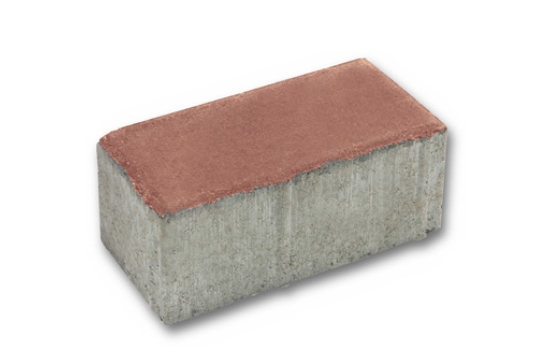
A two-layer tile is more dense, durable and frost-resistant than a single-layer tile, and even more so than a vibrocast one. Usually, a single-layer tile can crumble in case of non-compliance with the production technology, however, there are also cases that the front layer of a two-layer vibropressed tile can fly off during operation. The reason is a violation of manufacturing technology: incorrectly selected moisture content of the face and base layers of concrete. But this is a rarity, as a rule, the technology of two-layer vibrocompression provides for full automation of the process and the influence of the human factor in this case is minimized.
What is the best way to lay tiles and paving stones in the yard?
Paving stones should be laid only on a prepared surface, previously marked with pegs with a twine, outlining the slope for the drainage trays. The curb and curbs should be installed first.
There are several installation options: on an existing concrete base using sand-cement mixture or just on the sand.
To prepare the substrate for installation, you should:
- Remove the sod layer to a depth of 20 cm or more, depending on the soil
- Fill the resulting area with 10-20 mm crushed stone, followed by ramming with a vibrating plate weighing at least 50-75 kg
- Lay a 5 cm leveling layer of sand to smooth out the remaining irregularities
- When using cement - smooth out the sand-cement mixture
- Lay dry-pressed paving stones / cast tiles according to the required pattern and colors
- Tamp with the obligatory use of a rubber mat, in order to avoid damage to the surface of the cobbled / tiled covering
- Sprinkle joints with sand and cement
If this list of works for the improvement of the territory of the dacha seems difficult, then you can use the services of professional specialists.
Required set of tools: vibrating plate, angle grinder, diamond cutting discs for concrete, rubber hammer, hammer, level, plumb line, etc.
Mastek or Rifey?
The answer to this question has been known since the end of the last millennium. Of course, such seemingly familiar asphalt sidewalks have long been abandoned all over the world. Paving stones are both more aesthetically pleasing and more reliable. But what kind, cast or extruded? If you look closely at the sidewalks of developed countries, the answer to this question is clear. The lion's share of the produced paving slabs all over the world is accounted for by the products made by the vibrocompression method. The material for the production is sand-concrete dry mixes.
This technology is as follows. The concrete mix on the MASTEK vibropress vibrates in the punch-matrix (mold) under pressure. This method is distinguished by high productivity, a high degree of automation is possible, and paving slabs of various colors can be produced.
And what is Rifey paving slab casting? The concrete mix does not vibrate on a vibrating press, but on a vibrating table. Such a process is rather difficult to automate, requires long manual work, and the productivity is low. The resulting products will have low frost resistance, since they initially have a high water-cement ratio. To produce high-quality frost-resistant tiles, the manufacturer has to add cement, plasticizers and modifiers to the composition. The increased raw material costs correspondingly increase the cost of the product.
The pavement, cast or compressed, is even different in appearance and texture. Vibropressed Rifey tiles are rough on the surface, cast paving stones are smooth. Of course, it is more convenient to pave with rough tiles not only pedestrian zones and sidewalks, but also parking lots, transport stops, warehouses, terminals. Indeed, on such a surface, it is easier for road transport to accelerate or slow down. Molded slippery tiles do not cause problems with movement only in areas where the temperature is never below zero. The appearance of light frosts instantly makes the pavement with such tiles a real roller.
Vibro-pressed tiles are made of concrete with a low water-cement ratio. The cement consumption is optimized, and the strength increases - from М400 to М500, with it the frost resistance also grows - from the minimum 250 to the maximum 300 Мрз cycles. The color of the vibropressed paving stone Mastek continues to remain bright for a quarter of a century. In addition, low water absorption with low abrasion allow the tiles to be used for three decades.
Castable smooth tiles are characterized by the fact that they cannot sufficiently "breathe" the surface. With the onset of frost, the water freezes, which leads to cracking of the tiles. Among other disadvantages of casting, there is a large percentage of defects - the elements do not strictly coincide with each other, the surfaces are not always parallel. Tiles are difficult to install, and subsequently to be repaired. The surface of the cast tiles cannot be processed.
Vibro-pressed paving stones, on the contrary, are strictly geometric and their elements are completely identical. Parallel surfaces can be polished, sanded and even bush hammered (intentional anti-slip roughness or worn off top coat), that is, carry out the same operations as with natural stone.
All of the above obviously proves the advantages of vibropressed sidewalk in comparison with vibrated pavement. Cast tiles are neither practical nor profitable. Often, its production takes place in artisanal conditions, which even worse affects the final quality of the product. It is time for the domestic industry to abandon such a release and switch to automated production of paving slabs of reliable quality by the method of volumetric semi-dry vibrocompression, as it was done all over the world.
How to mix the solution correctly
We mix the mortar for paving slabs in the following sequence:
- Add plasticizer and dye to the drum with a small amount of water (1-1.5 buckets);
- We start the concrete mixer and stir the added components for one minute. From this time on, the mixer should work continuously until the solution is completely mixed;
- Then, observing the above proportions, cement is first added, and then sand and crushed stone.
- We carefully monitor the consistency of the solution in the drum. The solution should turn out to be viscous, but in no case liquid.
- The final step will be adding fiber to the finished solution. Stir for another 2-3 minutes. The solution is ready.
Casting and vibration processing
- The solution is poured into the previously lubricated (soapy or oil solution) forms exposed on the platform of the vibrating table.
- The vibration treatment process must be carefully monitored. As soon as foam forms on the surface, this is a signal that the degassing of the liquid is completed and the machine can be turned off.
Some people wonder why vibration treatment of the solution is needed, why it is simply impossible to pour the finished mixture into molds. The answer to this question lies in the tiny air bubbles that are in the hardened concrete. In severe frosts, they contribute to the splitting of paving slabs.
Drying and demoulding
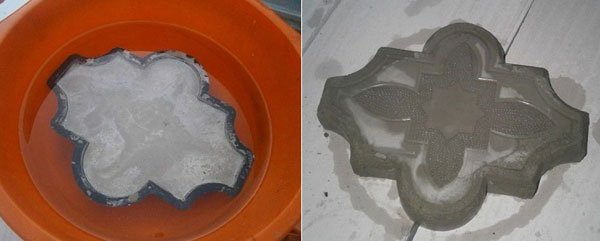
Cured concrete should be light gray.
In the summer period, the drying of castings should last at least 24 hours, in cool weather, at least 2 days. In order for the tile to come out of the mold more easily, it should be immersed in a container of hot water for 10-15 seconds. The molds are well rinsed with water and are ready to use again.
Important! It is not recommended to start up freshly cast tiles right away. To gain strength, it must be kept in the fresh air under the sun for another week.
Only after that the paving slabs are ready for use.
If you have made a decision to make paving slabs with your own hands, then we hope that this article will be a good help and help in your work.
Solution composition
To prepare a suitable solution, a plasticizer is taken, combined with a small volume of water, and poured into a concrete mixer. You need to add warm water, because cold water will not be able to dissolve the additives
During the mixing process, it is important to watch carefully so that all the plasticizer disperses in the solution.
The dye is combined with hot water in a ratio of 1 to 3. As a result, it is required to obtain a homogeneous mass, lumps will provoke the formation of craters on the surface of the products.
Then rubble, sand, then cement are poured in turn. Water is periodically added to the mixture to make it easier to mix. But the bulk of the water is poured at the end of mixing.
So the mixture is ready. It should be held on the trowel, not spread. Moreover, during pouring, the mixture is easily distributed in the mold.
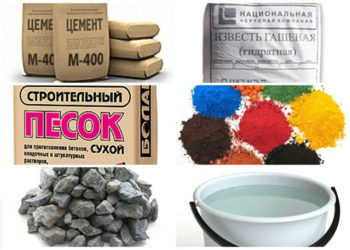 Casting solution composition
Casting solution composition
The ratio of the components in the solution
To mix concrete per square meter of 6 cm thick tiles, you need to take:
- a mixture of crushed stone and sand - 90 kg;
- cement 25 kg;
- plasticizer 100 g;
- dispersant 120 g;
- dye 800 g.
Lack of cast paving slabs and paving stones
The spread in thickness - vibrocasting tiles in height can differ significantly in a pack - up to 10 mm - this adversely affects the speed and quality of laying.Often, several cast tiles cannot be aligned on the surface, and different thicknesses of self-leveling tiles lead to the fact that some corners are recessed below the level, while others stick out above it. Therefore, it must be remembered that some laying teams may not undertake the installation of these materials, or ask for a higher price, since they will spend more time on laying it.
Low degree of frost resistance - when preparing a cement slurry, a large amount of water is used, including water that is not bound with cement, which subsequently evaporates and leaves behind pores, capillaries, saturated with water, which freezes destroys the concrete product. Special additives: dispersants, plasticizers only partially smooth out this negative effect.
Inhomogeneity of the structure, often the manifestation of layering - the settling of cement, as a heavier material, to the bottom of the mold (front surface), while the cast paving slabs are, as it were, in a case, if damaged, the concrete product collapses.
The main advantage of cast paving slabs is its low price, which is 20-30% lower than dry-pressed (vibro-pressed), and also that it is produced almost everywhere - while delivery costs are much lower than for a dry press.
Another advantage is the ability to manufacture large-sized concrete tiles with a small thickness, for example: 300 * 300 * 30, 400 * 400 * 40 mm, 500 * 500 * 60 mm.
What determines the cost of colored paving stones?
The price of both types of paving stones / tiles is influenced by the main indicators: thickness and color. In this case, the price for each color is set differently.
The thickness of dry-pressed concrete products starts from 40 mm. The most widespread are paving stones with a thickness of 60 mm. 80 and 100 mm are pavements for especially loaded roads, arrivals, ports (for the movement of multi-ton trucks), etc. In everyday life, only products with a thickness of 40 and 60 mm are applicable. A 40 mm tile, laid in accordance with the technology, is enough for a passenger car to enter. For freight transport 60 and 80 mm.
Concrete paving stones made by dry pressing can have the following dimensions:
100 * 200 * 40mm 100 * 200 * 60mm 100 * 200 * 80mm 100 * 100 * 60mm 200 * 200 * 60mm
And also forms: "Rhombus", "Wave", "Dumbbell", "Trapezium", "Hat of Monomakh", "Old City", etc.

